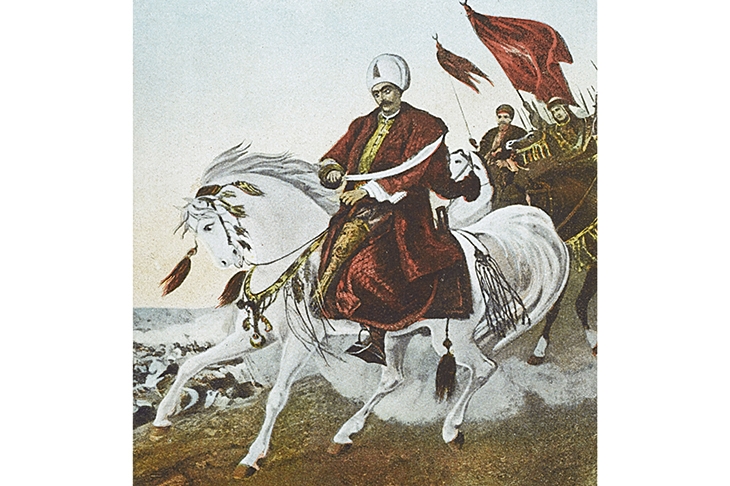Faber must take a rather dim view of British readers’ historical awareness these days. This is a biography of one of the greatest Ottoman sultans in the empire’s 600-year history, yet the publishers cannot bring themselves to mention his name in the book’s title. Perhaps they thought Selim I was too obscure, and maybe they’re right, but their reticence is not shared by Alan Mikhail’s American publishers, who rightly give the sultan his due. Never mind. Mikhail, chair of Yale’s history department and a specialist in Ottoman history, makes it his mission to demonstrate how this utterly compelling leader helped define his age, bending the world to his will. And he succeeds with a flourish.
Selim’s reign may not have been long —he only ruled from 1512 to 1520 — but he managed to fit an awful lot of conquest in. So much so that by the time of his death the Ottoman empire had almost trebled in size. He had gobbled up the Mamluk sultanate of Egypt, encompassing the Levant and swathes of the Arabian peninsula, including the holy cities of Mecca and Medina to provide added Islamic lustre to his dominions. He had also given the Safavid shah Ismail I a bloody nose at the Battle of Chaldiran in 1514, entering Tabriz in triumph to add to Iranian ignominy.
Selim’s rise to the throne was no less interesting than his time on it. Mikhail’s passages on the bouts of fratricide that necessarily accompanied an Ottoman prince’s succession are riveting. As the fourth of his father Bayazid’s ten sons, Selim was never expected to become sultan. While princeling governor of Trabzon from 1487 to 1510, however, he proved his military mettle in clashes with his heterodox Shiite neighbour of Iran, a carefully calibrated signal to the powerful military Janissary class that he would be a worthy successor to his doveish father.
Selim murdered two half-brothers and came chillingly close to bumping off his father too
It was only through sheer force of will and the guiding hand of his concubine mother Gülbahar Hatun, together with high intelligence and low cunning, that Selim ever made it to the top. He came chillingly close to bumping his father off to take the throne, instead forcing the sultan’s abdication with a ruthlessness matched by the subsequent murder of two half-brothers vying for the throne. His later nicknames of Selim the Grim and Selim the Resolute suggested this was not a man who would be trifled with. Fiery-tempered and formidable — the Venetian doge Andrea Gritti considered him a ‘ferocious and cunning’ war-monger with ‘a cruel streak’ — Selim was not big on bants.
At the Battle of Marj Dabiq in Syria in 1516, Selim trounced the Mamluks, paving the way for his conquest of the Middle East. A year later he administered the coup de grâce at the Battle of Ridaniya in Egypt, which obliterated the Mamluk sultanate for good. The deposed sultan Tuman was hunted down and killed, his body strung up for three days on one of the gates of Cairo pour décourager les autres.
Mikhail is right to argue that Ridaniya ‘changed the world’. Henceforth Selim stood at the very pinnacle of Muslim power, with Istanbul the bona fide capital of Islam. The incorporation of the Hejaz in western Arabia into his fast expanding dominions allowed him to add the ‘Servant of the Two Holy Places’ moniker to his other titles.
Mikhail offers a refreshingly Ottoman-centric picture of the 15th- and 16th-century Mediterranean. He presents Christopher Columbus’s bloody explorations in the Americas as the result of Ottoman supremacy closer to home. Yet one feels he is never entirely fair in his assessment of western Christendom when judged against eastern Islam. He writes of ‘Renaissance Europe’s blood lust against Islam’ while remaining silent on its mirror image. He attributes to a young Selim ‘Ottoman Islam’s ecumenical view of the world vs European Christianity’s violent efforts to achieve religious homogeneity’, while neglecting to add that there was very little ecumenical about Selim’s later wars against Shiite Iran. While self-criticism is necessary, self-flagellation is indulgent.
If the story of Columbus and his explorers was ‘indubitably one of crusade’, was not the expansion of the Ottoman empire indubitably one of jihad? We may agree that Columbus subscribed wholeheartedly to the notion of a ‘global civilisational war between Christendom and Islam’, but we might equally ask why Mikhail doesn’t acknowledge the classic Islamic distinction between the Dar al-Islam, or Abode of Islam, and the non-Muslim world, known quite literally as the Dar al-Harb, or Abode of War. It takes two to tango.
Mikhail’s confident, incident-filled prose rattles along nicely. There is only the occasional infelicity. One wonders, for example, whether Babur, great-great-great-grandson of the Turkic warlord Tamerlane, would ‘reach out’ to Selim, who in turn ‘reached out’ to regional leaders while preparing for war against Iran.
By the time of his death in 1520 (most likely from plague, or anthrax contracted from his horse), Selim was master of more territory than anyone else. He commanded the world’s most formidable military machine and could justifiably consider himself God’s Shadow on Earth. Not bad for a fourth-born son.






Comments